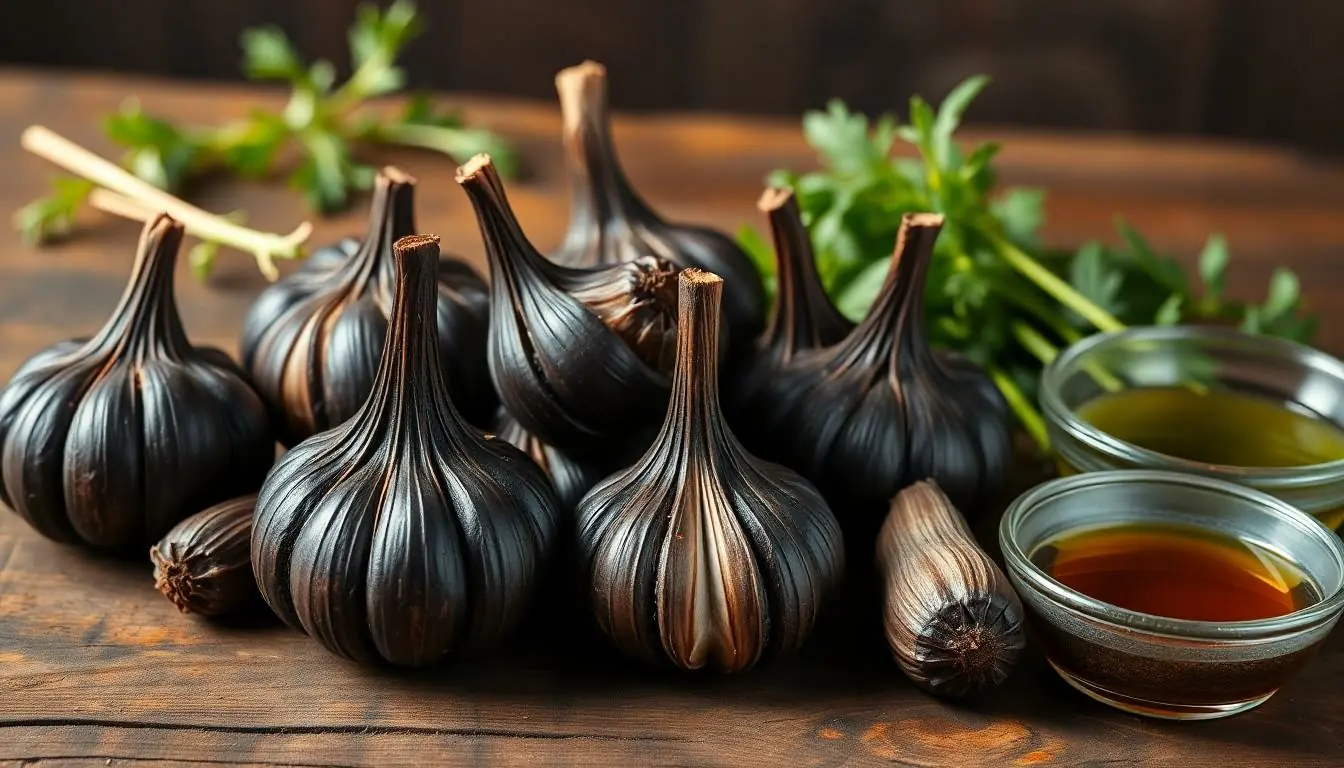Black garlic isn’t just a culinary curiosity; it’s a flavor powerhouse that can elevate any dish. With its sweet, umami-rich taste and striking appearance, it’s no wonder chefs and home cooks alike are raving about it. But why spend a fortune at gourmet stores when you can create this culinary gem right in your kitchen?
Making black garlic at home is easier than you think and a lot more fun than binge-watching that cooking show for the umpteenth time. With just a few simple ingredients and a dash of patience, you’ll be on your way to impressing friends and family. So grab your garlic and let’s dive into the magical world of fermentation—because who knew turning garlic into black gold could be this delightful?
Table of Contents
ToggleWhat Is Black Garlic?
Black garlic is aged garlic with a distinct flavor profile and unique texture. It undergoes a fermentation process that transforms its cloves, resulting in a sweet, tangy, and umami-rich taste. The aging process deepens its color, turning cloves black, and softening their consistency.
Fermentation occurs at controlled temperatures and humidity levels over several weeks, allowing the garlic to develop complex flavors. Many chefs appreciate black garlic for its versatility, as it complements various dishes and can enhance sauces, dressings, and marinades.
Nutritionally, black garlic is rich in antioxidants and has numerous health benefits. It contains compounds such as S-allyl cysteine, known for supporting heart health and boosting immunity. Many people also value black garlic for its potential anti-inflammatory properties.
Culinary enthusiasts and home cooks can incorporate black garlic into their meals easily. It can be used in pasta dishes, blended into dips, or added to roasted vegetables for a unique flavor. The combination of sweetness and earthiness makes it an appealing ingredient for diverse palates.
Black garlic serves as a flavorful addition to any kitchen, offering both taste and health advantages. Its transformative process and rich properties encourage culinary exploration and innovation.
Benefits of Black Garlic

Black garlic offers a range of benefits, making it a valuable addition to any kitchen. Its unique fermentation process enhances flavor and boosts nutritional content.
Nutritional Value
Black garlic contains various essential nutrients, including vitamins B6 and C, manganese, and antioxidants. One clove provides approximately 20 calories, 0.5 grams of protein, and 5 grams of carbohydrates. Each clove also delivers a significant amount of dietary fiber, promoting digestive health. Antioxidants, such as S-allyl cysteine, support cellular health and help combat oxidative stress. This nutrient profile contributes to its appeal as a health-conscious ingredient.
Health Benefits
Consumption of black garlic may support heart health through its ability to lower cholesterol levels and improve circulation. Documented research shows that the antioxidants in black garlic help reduce inflammation, potentially benefiting individuals with chronic conditions such as arthritis. Immune function receives a boost from the compounds present in black garlic, which may help fend off infections. Regular inclusion of black garlic in the diet offers numerous advantages, contributing to overall wellness and vitality.
Ingredients Needed
To make black garlic at home, a few essential ingredients and equipment are necessary. The primary ingredient is fresh garlic.
Fresh Garlic
Fresh garlic cloves are the cornerstone of black garlic. Choose whole bulbs, preferably organic, to ensure the best flavor. Each bulb yields multiple cloves, generally containing 10 to 12 cloves. The quality of garlic impacts the final product; therefore, opt for firm, unblemished bulbs. This selection guarantees a delicious fermentation outcome.
Equipment Required
Basic equipment streamlines the black garlic-making process. A rice cooker or slow cooker provides a controlled environment for the fermentation. Set the temperature to around 140°F (60°C) for optimal results. Use kitchen towels to regulate moisture and airflow. Airtight containers help maintain the garlic’s freshness during fermentation. A thermometer assists in monitoring temperature, ensuring a consistent environment throughout the aging process. Each piece of equipment plays a crucial role in achieving the desired flavor and texture of black garlic.
Step-By-Step Guide on How to Make Black Garlic at Home
Making black garlic at home involves a straightforward process. The following steps guide the way to crafting this unique ingredient.
Selecting the Right Garlic
Choose whole organic garlic bulbs for the best flavor. Look for firm bulbs with intact skins and no signs of sprouting. Quality garlic ensures rich fermentation and optimal taste. Fresh garlic produces a superior end product, differentiating between mediocre and outstanding black garlic.
Preparing the Garlic
Peel the desired number of garlic cloves, ensuring to keep them whole. Remove any excess moisture before proceeding with the fermentation. Wrapping the cloves in a clean kitchen towel helps absorb moisture and maintains air circulation. A clean workspace aids in preventing contamination, enhancing the overall result.
Fermentation Process
Set the rice cooker or slow cooker to a steady temperature of 140°F (60°C). Place the prepared garlic in the cooker, ensuring it doesn’t touch the sides. Maintain this temperature consistently for three to four weeks, allowing the transformation to occur. Check periodically to ensure proper fermentation without opening the lid too often, which could disrupt conditions.
Storage Tips
Once the fermentation process completes, allow the black garlic to cool completely. Store it in an airtight container to preserve its flavor and texture. Refrigeration extends its shelf life, keeping it fresh for up to several months. For long-term storage, consider freezing the cloves to maintain quality and prevent spoilage.
Common Mistakes to Avoid
Selecting poor-quality garlic bulbs results in subpar black garlic. High-quality, organic bulbs lead to a better fermentation outcome. Neglecting temperature control during fermentation can spoil the process. Maintaining a steady temperature around 140°F (60°C) ensures optimal results.
Overcrowding the fermenter with too many cloves might impede airflow. Space between the cloves allows for proper fermentation. Failing to monitor moisture levels can lead to unwanted mold. Using kitchen towels for regulating moisture is essential for success.
Not checking the fermentation progress regularly leaves uncertainty about readiness. Periodic checks provide insights into the aging process, ensuring desired flavor and texture. Forgetting to cool the black garlic before storage can diminish its quality. Cooling it properly preserves its unique taste and nutritional benefits.
Using non-airtight containers for storage risks spoilage. Opting for airtight containers helps maintain freshness for a longer period. Skipping refrigeration for long-term storage shortens the lifespan. Refrigerating or freezing black garlic ensures it remains flavorful for future use.
Rushing the fermentation process might lead to incomplete results. Black garlic typically requires three to four weeks of consistent conditions. Not using a thermometer may result in fluctuations in temperature. Consistent temperature is crucial for successful fermentation and ultimate flavor development.
When making black garlic, avoiding these mistakes enhances the overall experience. Following best practices leads to a successful and rewarding culinary adventure.
Making black garlic at home is a rewarding journey that opens the door to new culinary adventures. With its unique flavor and impressive health benefits, black garlic can elevate any dish. By following the simple steps outlined in the article and avoiding common pitfalls, anyone can successfully ferment garlic into this delicious ingredient.
The process not only enhances the taste of meals but also provides a nutritious boost to a diet. Whether used in sauces, dips, or roasted vegetables, black garlic adds depth and richness. Embracing this homemade approach allows for creativity in the kitchen while enjoying the satisfaction of crafting a gourmet ingredient from scratch.




